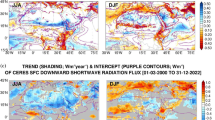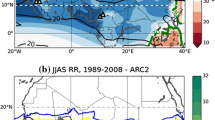Abstract
A mesoscale climate data set is created from simulations with a regional (limited area) model over West Africa on a 0.5° grid, covering six summers (June–September), 1998–2003. The Regional Model 3 (RM3) is the latest version run at the National Aeronautics and Space Administration Goddard Institute for Space Studies and the (Columbia University) Center for Climate Systems Research. RM3 simulations are driven by synchronous lateral boundary data four times daily from the National Center for Environmental Prediction reanalysis (NCPR) on a 2.5° grid and sea-surface temperatures from the reanalysis. Characteristics of African wave disturbances (AWD) are analyzed from the mesoscale data set and compared to prior published descriptions. Results show a remarkably high correlation in time and space between RM3 modeled precipitation and Tropical Rainfall Measurement Mission daily estimates, although the RM3 underestimates the frequency of the most extreme (high and low) precipitation rates. In addition, regional model precipitation was validated against gridded seasonal means from the East Anglia University data set and against a time series of daily rain gauge observations near Niamey, Niger. RM3 700 mb circulation shows evidence of considerable interannual variability in spectral properties that relate to AWD. Spectral amplitudes for 700 mb meridional wind time series peak most often in the range of 4 to 6-day periods over swaths traversed by AWD, often detected along 17°N and 4°N. AWD also create westward propagating bands of alternating southerlies and northerlies in NCPR, European Center for Medium-range Weather Forecasting 40-year reanalysis (ERA-40) and RM3 700 mb circulations. RM3 700 mb meridional winds are highly correlated with corresponding NCPR and ERA-40 values, but are usually weaker, so RM3 AWD generally have lower amplitudes. Significant rain events are not always associated with AWD. The RM3 shows good potential for sensitivity experiments that will contribute to our understanding of the physical mechanisms underlying the variability of the West African monsoon. An RM3 West Africa mesoscale climatology could also prove useful for future climate research.




















Similar content being viewed by others
References
Beven KJ, Kirkby MJ (1979) A physically-based variable contributing area model of basin hydrology. Hydrol Sci J 24:43–69
Burpee R (1972) The origin and structure of easterly waves in the lower troposphere of North Africa. J Atmos Sci 29:77–90
De Ela R, Laprise R, Denis B (2002) Forecasting skill limits of nested, limited-area models: a perfect-model approach. Mon Wea Rev 130:2006–2023
Del Genio A, Yao M-S (1993) Efficient cumulus parameterization for long-term climate studies. The GISS scheme. In: Emanuel K, Raymond D (eds) Cumulus parameterization, vol 24. American Meteorological Society Monograph Series, Boston, pp 181–184
Del Genio A, Yao M-S, Kovari W, Lo K-W (1996) A prognostic cloud water parameterization for global climate models. J Clim 9:270–304
Denis B, Laprise R, Caya D, Coté J (2002) Downscaling ability of one-way nested regional climate models: the Big-Brother experiment. Clim Dyn 18:627–646
Diedhiou A, Janicot S, Viltard A, de Felice P, Laurent H (1999) Easterly wave regimes and associated convection over West Africa and tropical Atlantic: results from NCEP/NCAR and ECMWF reanalyses. Clim Dyn 15:795–822
Druyan L, Fulakeza M, Thiaw W (2000) Regional model simulations of African wave disturbances. JGR 105:7231–7255
Druyan L, Hall T (1996) The sensitivity of African wave disturbances to remote forcing. J Appl Meteorol 35:1100–1110
Druyan L, Lonergan P, Saloum M (1996) African wave disturbances and precipitation at Niamey during July–August, 1987 and 1988. Clim Res 7:71–83
Druyan L, Lonergan P, Cohen J (1997) Case studies of African wave disturbances in gridded analyses. Mon Wea Rev 125:2520–2530
Druyan L (1998) The role of synoptic systems in the interannual variability of Sahel rainfall. Meteorol Atmos Phys 65:55–75
Druyan L, Fulakeza M, Lonergan P, Saloum M (2001) A regional model study of synoptic features over West Africa. Mon Wea Rev 129:1564–1577
Druyan L, Fulakeza M, Lonergan P (2004) Land surface influences on the West African summer monsoon: implications for synoptic disturbances. Meteorol Atmos Phys 86:261–273
Druyan L, Fulakeza M (2005) Mesoscale climate analysis over West Africa. CLIVAR Exch 34(3):20–35
Duvel JP (1990) Convection over tropical Africa and the Atlantic Ocean during northern summer. Part II: Modulation by easterly waves. Mon Wea Rev 118:1855–1868
Fortune M (1980) Properties of African squall lines inferred from time-lapse satellite imagery. Mon Wea Rev 108:153–168
Fritsch M, Carbone R (2004) Improving quantitative precipitation forecasts in the warm season. Bull Am Meterol Soc 85:955–965
Gibson JK, Kallberg P, Uppala S, Hernandez A, Nomura A, Serrano E (1997) ECMWF reanalysis project report series, part I ERA description. ECMWF, Reading, p 72
Giorgi F, Bates G, Nieman S (1993) The multiyear surface climatology of a regional atmospheric model over the Western United States. J Clim 6:75–95
Giorgi F, Marinucci M (1996) An investigation of the sensitivity of simulated precipitation to model resolution and its implication for climate studies. Mon Wea Rev 124:148–166
Grist J, Nicholson S (2001) A study of the dynamic factors influencing the rainfall variability in the West African Sahel. J Clim 14:1337–1359
Hansen J et al (2002) Climate forcings in Goddard Institute for Space Studies SI2000 simulations. JGR DOI: 10.1029/200IJD001143
Huffman GJ, Adler RF, Arkin P, Chang A, Ferraro R, Gruber A, Janowiak J, McNab A, Rudolph B, Schneider U (1997) The global precipitation climatology project (GPCP) combined precipitation dataset. Bull Am Meterol Soc 78:5–20
Kistler R et al (2001) The NCEP-NCAR 50-year reanalysis: monthly means CD-ROM and documentation. Bull Am Meterol Soc 82:247–267
Lamb P, Peppler R (1991) West Africa. In: Glantz MH, Katz RW, Nicholls N (eds) Teleconnections: linkages between ENSO, worldwide climate anomalies, and societal impacts. Cambridge University Press, London, pp 121–189
Landsea C, Gray W (1992) The strong association between western Sahelian monsoon rainfall and intense Atlantic hurricanes. J Clim 5:435–453
Lau W, Matsumoto J, Bollasina M, Berbery H (2004) Diurnal variability in the monsoon region: preliminary results from the CEOP inter-monsoon studies (CIMS). CEOP Newsl 5:2–4
Leung L, Qian Y, Bian X (2003) Hydroclimate of the western US based on observations and regional climate simulation of 1981–2000. Part I: Seasonal statistics. J Clim 16:1892–1911
Leung L, Qian Y, Bian X, Washington W, Han J, Roads J (2004) Mid-century ensemble regional climate change scenarios for the western US. Clim Change 62:75–113
Moustaoui M, Royer J-F, Chauvin F (2002) African easterly wave activity in a variable resolution GCM. Clim Dyn 19:289–301
Matthews E (1983) Global vegetation and land use: new high-resolution data bases for climate studies. J Clim Appl Meteorol 22:475–487
Matthews E (1984) Prescription of land-surface boundary conditions in GISS GCM II: a simple method based on high-resolution vegetation data bases. NASA Tech. Memo 86096. GSFC, Greenbelt, p 20
New M, Lister D, Hulme M, Makin I (2002) A high-resolution data set of surface climate over global land areas. Clim Res 21:1–25
Norquist D, Recker E, Reed R (1977) The energetics of African wave disturbances as observed during Phase III of GATE. Mon Wea Rev 105:334–342
Pytharoulis I, Thorncroft C (1999) The low-level structure of African easterly waves in 1995. Mon Wea Rev 127:2266–2280
Reed R, Norquist D, Recker E (1977) The structure and properties of African wave disturbances as observed during Phase III of GATE. Mon Wea Rev 105:317–333
Reed R, Klinker E, Hollingsworth A (1988) The structure and characteristics of African easterly wave disturbances as determined from the ECMWF operational analysis/forecast system. Meteorol Atmos Phys 38:22–33
Rosenzweig C, Abramopoulos F (1997) Land-surface model development for the GISS GCM. J Clim 10:2040–2054
Sultan J, Janicot S (2000) Abrupt shift of the ITCZ over West Africa and intraseasonal variability. Geophys Res Lett 27:3353–3356
Taleb E-H, Druyan L (2003) Relationships between rainfall and West African wave disturbances in station observations. Int J Climatol 23:305–313
Thorncroft C, Blackburn M (1999) Maintenance of the African easterly jet. Q J R Meteorol Soc 125:763–786
Thorncroft C, Hodges K (2001) African easterly wave variability and its relationship to Atlantic tropical cyclone activity. J Clim 14:1166–1179
Thorncroft C et al (2003) The JET2000 Project: Aircraft observations of the African Easterly Jet and African easterly waves. Bull Am Meterol Soc 84:337–351
Torrence C, Compo G (1998) A practical guide to wavelet analysis. Bull Am Meterol Soc 79:61–78
Uppala SM et al (2005) The ERA-40 re-analysis. Q J R Meteorol Soc 131:2961–3012
Ward MN et al (2004) Seasonal-to-decadal predictability of West Africa climate. CLIVAR Exch 9(14):19–20
Xue Y, Shukla J (1993) The influence of land surface properties on Sahel climate. Part I: Desertification. J Clim 6:2232–2245
Acknowledgements
The research was supported by the National Science Foundation grant no. ATM-0354589 and by the NASA Climate and Earth Observing System Programs. The authors gratefully acknowledge the assistance and participation of Gil Zamfirescu and Charles Sosa in processing some of the data for the study. The very helpful suggestions of three anonymous reviewers are also gratefully acknowledged.
Author information
Authors and Affiliations
Corresponding author
Rights and permissions
About this article
Cite this article
Druyan, L.M., Fulakeza, M. & Lonergan, P. Mesoscale analyses of West African summer climate: focus on wave disturbances. Clim Dyn 27, 459–481 (2006). https://doi.org/10.1007/s00382-006-0141-9
Received:
Accepted:
Published:
Issue Date:
DOI: https://doi.org/10.1007/s00382-006-0141-9




